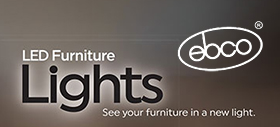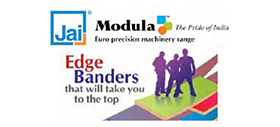Machining compact laminates needs precision, durability

Compact laminates present several challenges in cutting and machining due to their density and hardness. One of the most common issues is edge chipping and rough finishes.
The woodworking and interior design industries are constantly evolving, with an increasing focus on durability, aesthetics and precision. Compact laminates have emerged as game-changers in furniture and interior design due to their robust properties and versatile design possibilities.
This high-pressure structural laminate (HPL) is known for its exceptional durability, moisture resistance and visual appeal, making it a preferred choice for architects, designers and furniture manufacturers.
Compact laminate is a HPL created by compressing multiple layers of Kraft paper impregnated with thermos-setting resins under high pressure and temperature. The result is a dense, self-supporting material with exceptional durability.
The top layers feature decorative paper coated with a protective overlay, offering both visual appeal and enhanced resistance to wear and tear.
Compact laminate is highly durable, offering excellent resistance to impact, scratches and general wear, making it ideal for high-traffic environments. Unlike traditional laminates, it does not require a separate substrate, making it completely waterproof and suitable for humid and wet areas such as restrooms, kitchens and healthcare spaces.
Its chemical resistance makes it ideal for laboratory surfaces, while its robust outer layer protects against moderate heat exposure. The non-porous surface prevents bacteria and mold growth, ensuring a hygienic option for food-related and medical applications.
Additionally, compact laminate is UV and weather-resistant, making it suitable for both interior and exterior use. Certain variants are also designed with fire-retardant properties to meet strict safety standards.
Beyond its functional benefits, compact laminate offers aesthetic versatility, with a vast array of colors, textures and finishes that cater to diverse design preferences.
Many advantages
Unlike conventional laminates, compact laminate does not require a separate substrate, eliminating the risk of delamination. Its durability ensures a longer lifespan, making it a cost-effective choice in the long run.
Resistant to environmental factors such as humidity and temperature variations, it performs exceptionally well in both indoor and outdoor applications. With its combination of strength, resistance, and design flexibility, compact laminate has become a preferred choice for architects, designers and manufacturers seeking high-performance materials.
Compact laminate is extensively used in furniture, kitchen and trade fair construction, façade cladding, and sanitary applications due to its durability and ability to meet high-performance standards. Its resilience makes it ideal for demanding environments such as restroom partitions, countertops, and laboratory surfaces.
In both residential and commercial spaces, compact laminate enhances interior and exterior wall cladding with its modern aesthetics and long-lasting durability. In furniture and cabinetry, it is a preferred choice for worktops, modular furniture, and kitchen countertops, offering strength and wear resistance.
Its water-resistant properties make it well-suited for restroom partitions and lockers, commonly found in public and high-traffic areas. In healthcare and laboratory settings, compact laminate provides a hygienic, non-porous, and chemical-resistant surface, ensuring safety and ease of maintenance.
Additionally, its weather-resistant composition makes it an excellent option for façade panels and outdoor installations, where it withstands harsh environmental conditions without compromising structural integrity or appearance.
Machining challenges
Despite its many advantages, compact laminate presents several challenges in cutting and machining due to its density and hardness. One of the most common issues is edge chipping and rough finishes, as standard cutting tools often struggle to maintain clean, precise edges.
Additionally, the material’s hardness leads to high tool wear, requiring frequent replacements of conventional carbide tools, which increases operational costs and downtime.
Another challenge is heat generation during machining, as poor heat dissipation can result in burn marks on the surface, potentially compromising both the finish and structural integrity of the material.
These factors necessitate the use of specialized cutting techniques and high-performance tools to achieve optimal results.
To address the challenges of machining compact laminate, industry professionals rely on Leitz DP (diamond polycrystalline) tools. Designed for precision, durability and efficiency, the Leitz tool range offers tailored solutions for various machining applications, delivering outstanding quality and productivity.
For grooving and sizing, the Diamaster Pro Z1 and Z2 diamond-tipped routers deliver superior cutting performance. Their slightly positive cutting angle facilitates efficient chip ejection, ensuring smooth, chip-free surfaces and reducing the need for extensive cleaning and reworking.
This enhances overall efficiency, making the machining process more streamlined. Additionally, the diamond basic cutting edge is particularly effective for plunging, providing precision and durability for demanding applications.
Leitz’s Diamaster Plus Z2 router is engineered for grooving and sizing, offering neutral cutting characteristics and high feed rates. Its alternating cutting angle ensures clean, precise edges on both the top and bottom surfaces, delivering flawless cuts with every use.
The tool’s stable design supports high feed rates, making it a reliable choice for demanding applications. Additionally, a specialized version of the Diamaster Plus Z2 is optimised for the nesting process, featuring a negative cutting angle that prevents edge tearing and eliminates the need for reworking.
Routers, sawblades
Leitz router cutters are designed in various diameters to accommodate all conventional machines, offering exceptional longevity and multiple resharpening capabilities. In drilling applications, the HW solid Z2 drill, specifically engineered for HPL, guarantees breakout-free boreholes, significantly enhancing the quality of the final product.
Its innovative cutting-edge arrangement extends tool life and ensures greater stability, while the polished gullet area facilitates smooth chip removal, optimizing overall machining efficiency.
For panel sizing, Leitz circular sawblades and scoring sawblades ensure flawless cutting edges and smooth surfaces while enhancing productivity. By combining with-feed pre-scoring and against-feed cutting-off, these sawblades effectively prevent breakout, producing high-quality edges on both sides of the panel.
Available in carbide or diamond-tipped versions, they feature an advanced tooth geometry and laser-filled ornaments that significantly reduce noise levels. With the ability to be resharpened multiple times, these sawblades offer a cost-effective and durable solution for precise panel-sizing applications.
As compact laminate continues to redefine modern design and functionality, the need for precision tooling has never been greater. Leitz’s advanced DP tools empower manufacturers with the accuracy, durability, and efficiency required to meet the highest industry standards.
By investing in cutting-edge machining solutions, businesses can optimise production, reduce costs, and deliver flawless results. With Leitz’s expertise and global support network, achieving superior performance in compact laminate processing is not just possible, it’s the new standard.

– The writer is Head of Applications at Leitz Tooling Systems India, Bengaluru. He is an expert in woodworking industry solutions, precision tooling and application engineering.
Comments

- European symposium highlights formaldehyde emission limits
- Egger adopts holistic approach to waste management
- Weber machines dovetail into best practices
- Hymmen’s smart2i facilitates digitally mapping production
- Understanding paper impregnation
- Rising from the ashes
- Canada’s Western hemlock adorns Indore’s municipal hub
- Hans Weber sets up demo centre in Bengaluru
- More power to woodworkers!
- Record success in its silver jubilee
- New IWMMTA team steps into driver’s seat
- imos: enhancing furniture sales, production with AI
- ‘Eco-friendly’ artificial grass? You must be nuts!
- Ligna all set to strike gold this May
- ‘For customers, our lab is an open book’
- Anticipation for smart components at Interzum 2025
- Furtech 2025 beckons Indian furniture industry
- HIFF 2025 invites woodworking professionals in September
- CIFF 2025 reimagines global furniture innovation
- Decora makes a mark at Dubai Wood Show
- Understanding PUR glue in membrane press operations
- Machining compact laminates needs precision, durability
- Biesse Customer Care: innovations in support
- Canadian Wood showcases innovative luxury designs
- Felder reaffirms status as important player in India
- FFSC pavilion bridging skill gap
- Automation to VR, Homag shows it all
- SETS Machinery showcases coating solutions
- Sugatsune impresses with space-saving solutions
- Exterior wood: Rejuvenating with Protego’s solutions
- Yalian’s integrated pressing solutions
- Garant’s smart filters ensure safer workspaces
- Aryamman ushers Staynu tech for furnishings
- Hafele’s RE-Twist raises bar on security
- AWM makes lock, hinge slots easy work
- Biesse’s Akron ensures edge banding excellence
- Hettich sliding systems for precision functions
- Jai’s top-of-the-line wood and panel processing machines
- Schmalz shows benefits of automated handling
- Richwood’s Calibrated Filler is a gamechanger
- Coohom gives wood interiors AR edge






































